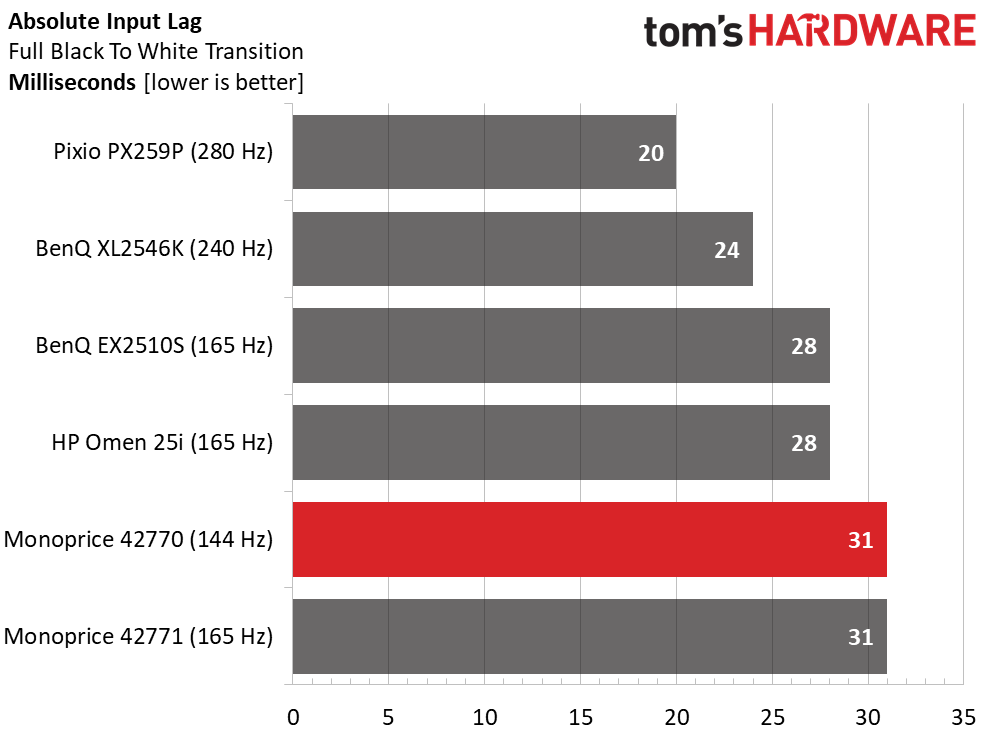Why you can trust Tom's Hardware
To compare the 42770’s performance with other similar monitors, we’ve rounded up some 25-inch, and one 27-inch, panels from our database. We found that all of them ran at higher refresh rates, but they also cost more. Does that mean 144 Hz is a deficit? Not at all, as we quickly discovered. For our comparisons, we used Pixio’s PX259 Prime, BenQ’s XL2546K & EX2510S, Monoprice’s 42771 and HP’s Omen 25i.
Pixel Response and Input Lag
Click here to read up on our pixel response and input lag testing procedures.


Obviously, 240 or 280 Hz will get you a visibly more responsive panel if you have enough video card power to run at those frame rates (see our best graphics cards list). But 165 Hz is only 1ms quicker. The difference is visible but tiny – well worth the cost savings if you’re building on a budget. In the lag test, the 42771 equaled its faster 27-inch stablemate, which costs $100 more. And it’s only a bit slower than the other 165 Hz screens. 31ms is plenty quick and will provide instant control response for all but the most skilled competitors. Whether you’re using a PC or console for gaming, the 42770 is more than competent.
Viewing Angles
IPS panels have improved their viewing angles in the past two years. The 42770 is an AHVA variant which makes it even better. From the sides, light is reduced by around 30% and there is only a slight shift to red. The top view goes green with a 50% light falloff and reduced detail. This monitor is shareable, but at 25 inches, that won’t be a common occurrence.
Screen Uniformity
To learn how we measure screen uniformity, click here.
Our 42770 sample showed an excellent result in the black screen uniformity test. We saw no anomalies at all, with perfect corners and edges. No glow was present, even with the room completely dark. 8.49% is a top score in this test and puts the 42770 well above the average.
Get Tom's Hardware's best news and in-depth reviews, straight to your inbox.
Current page: Response, Input Lag, Viewing Angles and Uniformity
Prev Page Features and Specifications Next Page Brightness and Contrast
Christian Eberle is a Contributing Editor for Tom's Hardware US. He's a veteran reviewer of A/V equipment, specializing in monitors. Christian began his obsession with tech when he built his first PC in 1991, a 286 running DOS 3.0 at a blazing 12MHz. In 2006, he undertook training from the Imaging Science Foundation in video calibration and testing and thus started a passion for precise imaging that persists to this day. He is also a professional musician with a degree from the New England Conservatory as a classical bassoonist which he used to good effect as a performer with the West Point Army Band from 1987 to 2013. He enjoys watching movies and listening to high-end audio in his custom-built home theater and can be seen riding trails near his home on a race-ready ICE VTX recumbent trike. Christian enjoys the endless summer in Florida where he lives with his wife and Chihuahua and plays with orchestras around the state.

